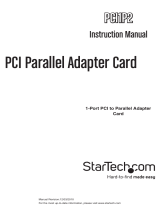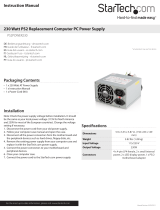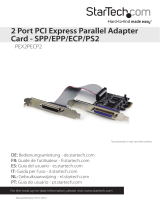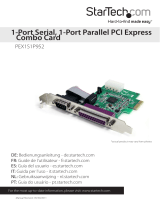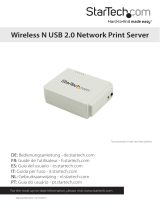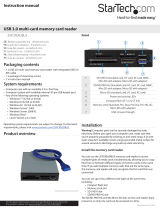Page is loading ...

Manual Revision: 01/27/2012
DE: Bedienungsanleitung - de.startech.com
FR: Guide de l'utilisateur - fr.startech.com
ES: Guía del usuario - es.startech.com
IT: Guida per l'uso - it.startech.com
NL: Gebruiksaanwijzing - nl.startech.com
PT: Guia do usuário - pt.startech.com
For the most up-to-date information, please visit: www.startech.com
PCI2S1P
PCI Serial Parallel Combo Card
with 16550 UART
*actual product may vary from photos

FCC Compliance Statement
This equipment has been tested and found to comply with the limits for a Class B digital device,
pursuant to part 15 of the FCC Rules. These limits are designed to provide reasonable protection
against harmful interference in a residential installation. This equipment generates, uses and can
radiate radio frequency energy and, if not installed and used in accordance with the instructions,
may cause harmful interference to radio communications. However, there is no guarantee that
interference will not occur in a particular installation. If this equipment does cause harmful
interference to radio or television reception, which can be determined by turning the equipment
o and on, the user is encouraged to try to correct the interference by one or more of the
following measures:
Reorient or relocate the receiving antenna.
Increase the separation between the equipment and receiver.
Connect the equipment into an outlet on a circuit dierent from that to which the receiver is
connected.
Consult the dealer or an experienced radio/TV technician for help.
Use of Trademarks, Registered Trademarks, and other Protected Names and Symbols
This manual may make reference to trademarks, registered trademarks, and other protected
names and/or symbols of third-party companies not related in any way to StarTech.com.
Where they occur these references are for illustrative purposes only and do not represent an
endorsement of a product or service by StarTech.com, or an endorsement of the product(s) to
which this manual applies by the third-party company in question. Regardless of any direct
acknowledgement elsewhere in the body of this document, StarTech.com hereby acknowledges
that all trademarks, registered trademarks, service marks, and other protected names and/or
symbols contained in this manual and related documents are the property of their respective
holders.

Instruction Manual
i
Table of Contents
Introduction ........................................................................................................................................................1
Features ...........................................................................................................................................................1
Before You Begin........................................................................................................................................1
System Requirements ............................................................................................................................1
Contents .........................................................................................................................................................1
Installation............................................................................................................................................................2
Installing the Card.....................................................................................................................................2
Installing the Drivers ...............................................................................................................................3
Verifying Your Installation (Windows) ..........................................................................................4
Troubleshooting ...............................................................................................................................................5
Specications .....................................................................................................................................................7
Technical Support ...........................................................................................................................................8
Warranty Information ....................................................................................................................................8

Instruction Manual
1
Introduction
Thank you for purchasing a StarTech.com Slot Saver PCI card to your computer. This product
allows you to add 2 serial ports and 1 ECP parallel port to your computer using a space-saving
single card design. Perfect for small form factor and other reduced footprint case designs, you
can add support for your existing peripherals and devices using Plug and Play setup and ports
that often outperform integrated serial and parallel ports.
Features
• Fully complies with the IEEE-1284 standard and supports BPP, SPP, EPP, and ECP parallel data
transfer modes
• Fast data transfer rates often outperform built-in ports (up to 960 Kbits/sec. on serial ports,
1.5 Mbits/sec. on the parallel port)
• Complies with Plug and Play standards
• Backed by StarTech.com’s lifetime warranty
Before You Begin
To ensure a quick and easy card installation, please read through this section carefully before
attempting to install the card.
System Requirements
• A computer with an available PCI slot
• Microsoft® Windows® 95/ 98/9 8SE/ ME/ NT/ 2000/ XP/ Server 2003/ Vista/ Server 2008 R2/ 7
(32/64-bit), or Windows XP Embedded/ POS Ready 2009/ Embedded System 2009 OS/
CE 5.0/ 6.0, or DOS, or Apple® Mac OS® 10.4/ 10.5, or Linux®
Contents
This package should contain:
• 1 x PCI Serial/ Parallel Card
• 1 x Installation CD
• 1 x Instruction Manual

Instruction Manual
2
Installation
WARNING! PCI cards, like all computer equipment, can be severely damaged by static electricity.
Be sure that you are properly grounded before opening your computer case or touching your PCI
card. StarTech.com recommends that you wear an anti-static strap when installing any computer
component. If an anti-static strap is unavailable, discharge yourself of any static electricity build-
up by touching a large grounded metal surface (such as the computer case) for several seconds.
Also be careful to handle the PCI card by its edges and not the gold connectors.
Installing the Card
1. Make sure that your system is unplugged and you are grounded.
2. Remove the cover of your system (see your computer's user manual for details, if necessary)
and gently turn your computer onto its side.
3. Locate an empty PCI slot (usually white in color) and remove the metal plate that covers the
rear bracket. You may need a Phillips screwdriver to perform this step.
Retain the screw! You will need it to secure the card later.
PCI slots
*screenshots/photos are for reference only
4. Gently insert the card into the empty slot, making sure it is rmly seated.
5. Secure the card in place using the screw you removed in Step 3.
6. Connect the ribbon cable with the parallel port to the card with the red stripe facing Pin 1 as
indicated on the connector. Remove the metal plate from an available PCI slot bracket.
Secure the port in the empty bracket using the screw you removed.
7. Put the computer case back on.

Instruction Manual
3
Installing the Drivers
If you lose your installation CD, these drivers are available as a free download from our website.
Visit www.startech.com and click on the Downloads link for more information.
Windows 95/ 98/ 98SE/ ME
1. Windows should automatically detect the new hardware. At the Add New Hardware Wizard
window, click Next.
2. Select Search for the best driver for your devices (Recommended) and click Next.
3. Insert the installation CD into your computer’s CD-ROM or other optical drive and check the
Specify a location option.
4. In the space provided, enter x:\win9x (where “x:” is the letter of your CDROM drive and win9x
is your OS version: one of win95, win98, winME) and click Next.
5. The Wizard will copy the needed les. Follow the on-screen prompts to complete the
installation. If prompted, restart the computer to begin using your devices.
Windows NT 4.0
1. Insert the installation CD into your computer’s CD-ROM or other optical drive and double-
click My Computer.
2. Double click the WinNT folder. Double-click the WinNT.exe le and follow the on-screen
prompts.
Windows 2000/ XP/ Server 2003/ Vista/ Server 2008 R2/ 7
1. Windows will automatically detect the new hardware and start the Add New Hardware
Wizard. Click Next.
2. Insert the installation CD that came with the card into your computer’s CD-ROM or other
compatible optical drive. Choose Install the software automatically. Click Next.
3. You may receive a warning that the driver is not digitally signed. Choose Continue Anyway
when prompted to complete the installation.
4. When Windows is done copying les, you will see a message above the System Tray (next to
the clock) stating that the card is installed and ready to use. You may now begin using
your devices.

Instruction Manual
4
DOS and Linux Conguration
For conguration details for DOS please refer to the documents in the DOS folder on the
installation CD. For Linux conguration information, please refer to the “Troubleshooting” section
of this manual on the next page.
Verifying Your Installation (Windows)
Windows 95/ 98/ 98SE/ ME
1. Go to Start > Settings > Control Panel.
2. Double click System.
3. Click the Hardware tab.
4. If the card and related components do not appear with a red x or yellow exclamation point
(!) next to them, Windows has not detected a problem with the installation and the card
should function normally.
Windows 2000/ XP/ Server 2003
1. Go to Start > Settings > Control Panel.
2. Double click System.
3. Click the Hardware tab and choose Device Manager.
4. If the card and related components do not appear with a red x or yellow exclamation point
(!) next to them, Windows has not detected a problem with the installation and the card
should function normally.

Instruction Manual
5
Troubleshooting
Q: Do these cards work with point-of-sale (POS) systems, manufacturing equipment, software
unlock keys, and other specialized applications?
A: The answer depends on whether the devices you need to use are designed to work with
specic system resources. Because StarTech.com PCI parallel and serial cards are designed to
work with the Plug and Play standard, the computer allocates the resources needed to use the
card in cooperation with the operating system (OS). Some software applications and devices can
only access a port using older reserved, pre-dened resources (for example, LPT1 at memory
address 378 and an IRQ setting of 7). Consult your documentation to see if the software and/or
hardware you are using has this requirement. If so, you will not be able to use a PCI card. Instead,
you can use an ISA based card like StarTech.com’s ISA1P (parallel) or ISA1S550 (serial) that can
be hard congured to use a specic setting. Check the documentation for your computer or
motherboard to see if you have the necessary ISA slot(s) for this solution.
Q: I need to add several parallel ports to my computer, but I am having problems when I have
more than three parallel ports installed in my computer. Why?
A: While Windows will support more than three parallel ports (up to nine in total), LPT4 through
LPT9 must be congured by editing critical system les, a task that should beundertaken by
experienced users only. Microsoft oers support on how to make those modications.
Q: I have installed the card, it is assigned a LPT port number and appears without any warnings
in Device Manager, but it does not appear as an option when I attempt to install or re-congure
a printer to the port. How can I correct this?
A: You can manually install the port(s) so they are available to printers, using the following
instructions:
1. On the opening screen of the Add Printer Wizard, click Next.
2. Choose Local Printer and uncheck Automatically detect and install my Plug and Play printer.
Click Next.
3. Choose Create a new port and select Local Port from the Type: drop-down list. Click Next.
4. A dialog box will appear that prompts you to enter a name for the new port. Type LPTx in
the box (where “x” is the number assigned in Device Manager to the port you are adding,
without a colon). Click OK.
5. Continue the rest of the printer installation process, following the on-screen prompts.
Q: I have installed the card, and a NetMos Parallel Port appears in Device Manager, but does not
have an LPT port number assigned. How can I correct this?
A: Right click the NetMos Parallel Port entry in Device Manager and choose Uninstall from the
menu. Power o the computer and re-install the card in a dierent PCI slot according to the
instructions in the manual.

Instruction Manual
6
Q: How do I install this card in Linux?
A: Once you have physically installed the card in the computer, follow the following steps to
activate the port(s) in the operating system:
1. List the resources assigned to the PCI card by typing this command:
more /proc/pci
The response will include something similar to the following, however, yours will be dierent:
Bus 0, Device 11, function 0:
Serial controller : Unknown vendor Unknown device (rev 01).
Vendor id=9710, Device id=9715
Medium devsel. Fast back-to-back capable. IRQ 11
I/O at 0xc000 [0xc001] printer port 1
I/O at 0xc400 [0xc401] ECP/EPP cong registers 1
I/O at 0xc800 [0xc801] printer port 2
I/O at 0xd000 [0xd001] ECP/EPP cong registers 2
I/O at 0xd400 [0xd401] not used
I/O at 0xd800 [0xd801] not used
2. Unload the parport_pc.o module by typing in this command:
rmmod parport_pc.o
3. Reload the parport_pc.o module to include the new parallel port. The following example
assumes the resources discovered in step 1 and a built-in motherboard parallel port with a
memory address of 378 and an IRQ setting of 7.
insmod parport_pc.o io=0x378,0xc000,0xc800 irq=7,11,none
The rst port assigned will be /dev/lp0, the second will be /dev/lp1, etc. In this case, the
built-in parallel port will be assigned /dev/lp0, and the port on the PCI parallel card will be /
dev/lp1. You will need to follow a similar conguration methodology for the serial port
module: contact your documentation or an experienced Linux user for details.
Q: I am having trouble printing using a port on the PCI parallel card, but the card and printer
seem to be installed correctly. How can I x this problem?
A: Some older printers may have drivers that may have diculty working with virtual ports,
since they do not use specic hardware resources. To test whether this is the case, you can try
installing a newer printer on the problem port. If it prints correctly, then it is likely a software
problem: download the most current drivers from the Web site of the printer manufacturer
to see if that corrects the issue. If not, move the printer to a built-in printer port permanently
and use a newer printer with the port(s) on the PCI card. If that is not possible, you can use an
ISA-based card like StarTech.com’s ISA1P that can be hard-congured to use a specic setting.
Check the documentation for your computer or motherboard to see if you have the necessary
ISA slot(s) for this solution.

Instruction Manual
7
Specications
Host Interface 32-bit PCI (5V)
Form Factor
Full prole card + parallel port (via ribbon
cable)
Chipset MosChip MCS9835
Connectors
2 x 9-pin DB9 female
1 x 25-pin DB25 female
Maximum Data Transfer Speed
960 Kbits/sec. (serial)
1.5 Mbits/sec. (parallel)
Supported Serial Protocol RS-232
Parallel Modes Supported IEEE-1284 (BPP, SPP, PS2, EPP, ECP modes)
Regulatory and Other
Certications
FCC Class B, CE, UL

Instruction Manual
8
Technical Support
StarTech.com’s lifetime technical support is an integral part of our commitment to provide
industry-leading solutions. If you ever need help with your product, visit www.startech.com/
support and access our comprehensive selection of online tools, documentation, and downloads.
Warranty Information
This product is backed by a lifetime warranty.
In addition, StarTech.com warrants its products against defects in materials and workmanship for
the periods noted, following the initial date of purchase. During this period, the products may
be returned for repair, or replacement with equivalent products at our discretion. The warranty
covers parts and labor costs only. StarTech.com does not warrant its products from defects or
damages arising from misuse, abuse, alteration, or normal wear and tear.
Limitation of Liability
In no event shall the liability of StarTech.com Ltd. and StarTech.com USA LLP (or their ocers,
directors, employees or agents) for any damages (whether direct or indirect, special, punitive,
incidental, consequential, or otherwise), loss of prots, loss of business, or any pecuniary loss,
arising out of or related to the use of the product exceed the actual price paid for the product.
Some states do not allow the exclusion or limitation of incidental or consequential damages. If
such laws apply, the limitations or exclusions contained in this statement may not apply to you.

Hard-to-nd made easy. At StarTech.com, that isn’t a slogan. It’s a promise.
StarTech.com is your one-stop source for every connectivity part you need. From
the latest technology to legacy products — and all the parts that bridge the old and
new — we can help you nd the parts that connect your solutions.
We make it easy to locate the parts, and we quickly deliver them wherever they need
to go. Just talk to one of our tech advisors or visit our website. You’ll be connected to
the products you need in no time.
Visit www.startech.com for complete information on all StarTech.com products and
to access exclusive resources and time-saving tools.
StarTech.com is an ISO 9001 Registered manufacturer of connectivity and technology
parts. StarTech.com was founded in 1985 and has operations in the United States,
Canada, the United Kingdom and Taiwan servicing a worldwide market.
/

